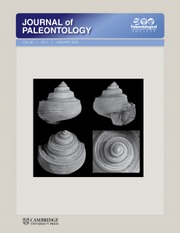Crossref Citations
This article has been cited by the following publications. This list is generated based on data provided by
Crossref.
Schiffbauer, James D.
and
Xiao, Shuhai
2014.
An Examination of Life History and Behavioral Evolution Across the Ediacaran–Cambrian Transition.
Journal of Paleontology,
Vol. 88,
Issue. 2,
p.
205.
Taylor, Edward W.
Cardimona, David A.
and
Hoover, Richard B.
2014.
Microfossils and biomolecules in carbonaceous meteorites: possibility of life in water-bearing asteroids and comets.
Vol. 9226,
Issue. ,
p.
922602.
MOCZYDŁOWSKA, MAŁGORZATA
BUDD, GRAHAM E.
and
AGIĆ, HEDA
2015.
Ecdysozoan-like sclerites among Ediacaran microfossils.
Geological Magazine,
Vol. 152,
Issue. 6,
p.
1145.
Szczepanik, Zbigniew
and
Żylińska, Anna
2016.
The oldest rocks of the Holy Cross Mountains, Poland – biostratigraphy of the Cambrian Czarna Shale Formation in the vicinity of Kotuszów.
Acta Geologica Polonica,
Vol. 66,
Issue. 3,
p.
267.
Budd, Graham E.
and
Jackson, Illiam S. C.
2016.
Ecological innovations in the Cambrian and the origins of the crown group phyla.
Philosophical Transactions of the Royal Society B: Biological Sciences,
Vol. 371,
Issue. 1685,
p.
20150287.
Van Iten, Heyo
Leme, Juliana M.
Pacheco, Mírian L. A. F.
Simões, Marcello G.
Fairchild, Thomas R.
Rodrigues, Fábio
Galante, Douglas
Boggiani, Paulo C.
and
Marques, Antonio C.
2016.
The Cnidaria, Past, Present and Future.
p.
31.
Moczydłowska, Małgorzata
2016.
Algal affinities of Ediacaran and Cambrian organic-walled microfossils with internal reproductive bodies:Tanariumand other morphotypes.
Palynology,
Vol. 40,
Issue. 1,
p.
83.
Moczydłowska, Małgorzata
and
Meng, Fanwei
2016.
The Ediacaran
Aspidella
-type impressions in the Jinxian successions of Liaoning Province, northeastern China
.
Lethaia,
Vol. 49,
Issue. 4,
p.
617.
LoDuca, S. T.
Bykova, N.
Wu, M.
Xiao, S.
and
Zhao, Y.
2017.
Seaweed morphology and ecology during the great animal diversification events of the early Paleozoic: A tale of two floras.
Geobiology,
Vol. 15,
Issue. 4,
p.
588.
Yin, Lei-Ming
Borjigin, Tenger
Knoll, Andrew H.
Bian, Li-Zeng
Xie, Xiao-Min
Bao, Fang
and
Ou, Zhi-Ji
2017.
Sheet-like microfossils from hydrothermally influenced basinal cherts of the lower Cambrian (Terreneuvian) Niutitang Formation, Guizhou, South China.
Palaeoworld,
Vol. 26,
Issue. 1,
p.
1.
Zhang, Xingliang
Liu, Wei
Isozaki, Yukio
and
Sato, Tomohiko
2017.
Centimeter-wide worm-like fossils from the lowest Cambrian of South China.
Scientific Reports,
Vol. 7,
Issue. 1,
Geyer, Gerd
and
Landing, Ed
2017.
The Precambrian–Phanerozoic and Ediacaran–Cambrian boundaries: a historical approach to a dilemma.
Geological Society, London, Special Publications,
Vol. 448,
Issue. 1,
p.
311.
Hoshino, Yosuke
Poshibaeva, Aleksandra
Meredith, William
Snape, Colin
Poshibaev, Vladimir
Versteegh, Gerard J. M.
Kuznetsov, Nikolay
Leider, Arne
van Maldegem, Lennart
Neumann, Mareike
Naeher, Sebastian
Moczydłowska, Małgorzata
Brocks, Jochen J.
Jarrett, Amber J. M.
Tang, Qing
Xiao, Shuhai
McKirdy, David
Das, Supriyo Kumar
Alvaro, José Javier
Sansjofre, Pierre
and
Hallmann, Christian
2017.
Cryogenian evolution of stigmasteroid biosynthesis.
Science Advances,
Vol. 3,
Issue. 9,
Lyons, Timothy W.
Droser, Mary L.
Lau, Kimberly V.
Porter, Susannah M.
Evans, Scott D.
Diamond, Charles W.
Droser, Mary L.
and
Lyons, Timothy W.
2018.
Dynamic oxygen and coupled biological and ecological innovation during the second wave of the Ediacara Biota.
Emerging Topics in Life Sciences,
Vol. 2,
Issue. 2,
p.
223.
Peel, John S.
Willman, Sebastian
and
Álvaro, Javier
2018.
The Buen Formation (Cambrian Series 2) biota of North Greenland.
Papers in Palaeontology,
Vol. 4,
Issue. 3,
p.
381.
Muscente, A.D.
Boag, Thomas H.
Bykova, Natalia
and
Schiffbauer, James D.
2018.
Environmental disturbance, resource availability, and biologic turnover at the dawn of animal life.
Earth-Science Reviews,
Vol. 177,
Issue. ,
p.
248.
Thomas, Brian
and
Taylor, Stephen
2019.
Proteomes of the past: the pursuit of proteins in paleontology.
Expert Review of Proteomics,
Vol. 16,
Issue. 11-12,
p.
881.
Georgieva, Magdalena N.
Little, Crispin T. S.
Watson, Jonathan S.
Sephton, Mark A.
Ball, Alexander D.
and
Glover, Adrian G.
2019.
Identification of fossil worm tubes from Phanerozoic hydrothermal vents and cold seeps.
Journal of Systematic Palaeontology,
Vol. 17,
Issue. 4,
p.
287.
Walde, Detlef Hans-Gert
Weber, Bernd
Erdtmann, Bernd- D.
and
Steiner, Michael
2019.
Taphonomy ofCorumbella wernerifrom the Ediacaran of Brazil: sinotubulitid tube or conulariid test?.
Alcheringa: An Australasian Journal of Palaeontology,
Vol. 43,
Issue. 3,
p.
335.
Selly, Tara
Schiffbauer, James D.
Jacquet, Sarah M.
Smith, Emily F.
Nelson, Lyle L.
Andreasen, Brock D.
Huntley, John Warren
Strange, Michael A.
O’Neil, Gretchen R.
Thater, Casey A.
Bykova, Natalia
Steiner, Michael
Yang, Ben
and
Cai, Yaoping
2020.
A new cloudinid fossil assemblage from the terminal Ediacaran of Nevada, USA.
Journal of Systematic Palaeontology,
Vol. 18,
Issue. 4,
p.
357.

